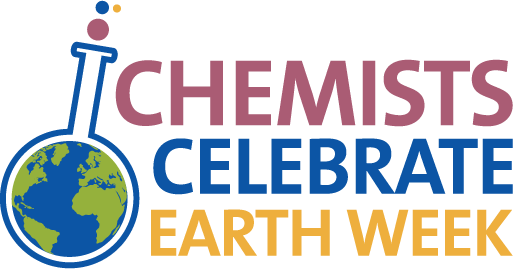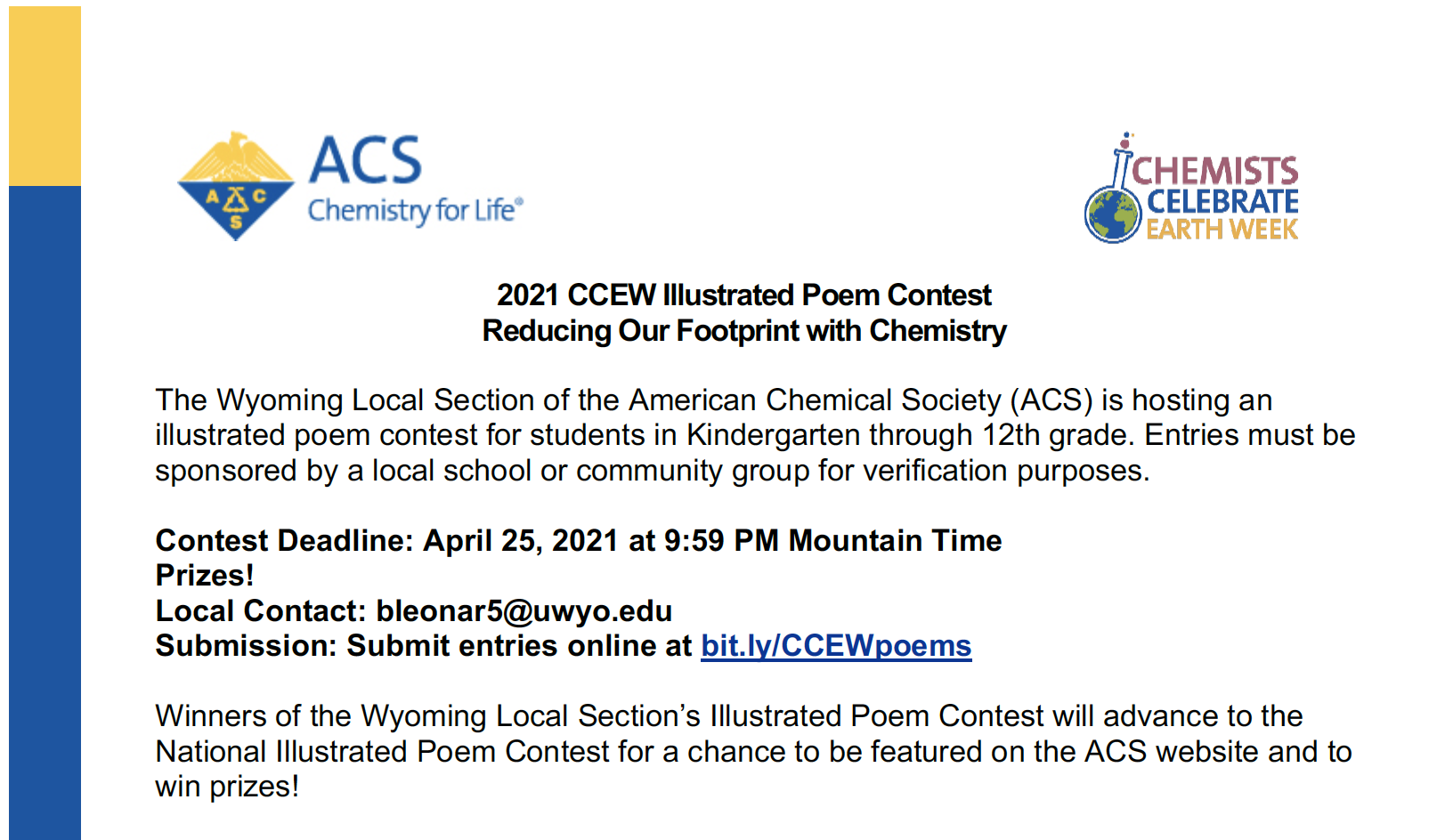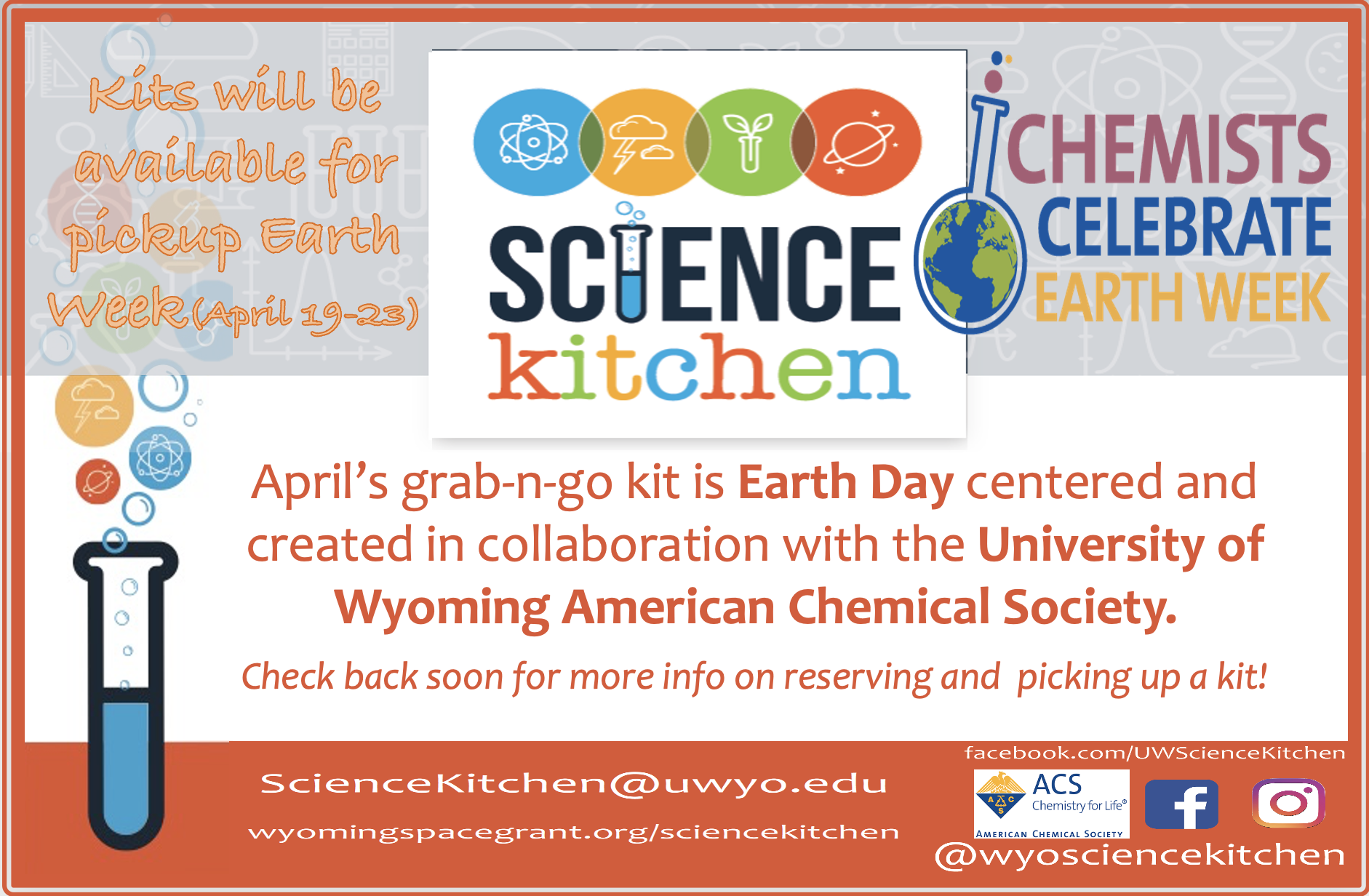

Chemists Celebrate Earth Week!
Consider signing up for our PreK-12 Email List for future opportunities.
Special thanks to Dr. Brian Leonard and the Wyoming local section of the American Chemical Society for the design and creation of this month’s kits!

Below you can find activity guides as well as videos for this month’s activities!
This month’s kit has three different activities:
Shrink Your Footprint with Shrinky Dinks
Find the Footprint of Your Favorite Snacks
Sun Power!
experimenting with UV Beads
Some plastic food containers and lids can take the heat. They come out of the dishwasher clean and ready for the next use. Other kinds of plastic containers bend or shrink when they get too hot. That makes them not-so-reusable as food containers. Let’s see if we can find another way to reuse these types of plastics, in a way that is fun and interesting!
Have you ever thought about where your favorite snacks come from? Maybe you buy them at the store, but how did they get to the store? In this activity, you’ll think about the amount of energy and resources needed to make your favorite snack food and get it to you fresh, delicious, and undamaged.
Solar power is power generated directly from sunlight. Solar power can be used for heat energy or converted into electric energy. However we have to be careful! UV is an invisible type of light from the Sun. It can burn our skin and while most UV is blocked by our Earth’s ozone layer and atmosphere, but some still gets through. In this activity, you’ll experiment using solar beads to detect and protect against UV light!
This activity will require adult supervision and the use of an oven!
Parents, you may need to help your kids do some additional research for this one!
Parents, the solar beads are pretty small! They may present a choking risk for young children.
Introduction
Adapted from the American Chemical Society’s CCEW 2021 Celebrating Chemistry
Introduction: Some plastic food containers and lids can take the heat. They come out of the dishwasher clean and ready for the next use. Other kinds of plastic containers bend or shrink when they get too hot. That makes them not-so-reusable as food containers. Let’s see if we can find another fun and interesting way to reuse these types of plastics!
Supplies
Provided Supplies: shrinky dink material, graph paper, pencil, permanent marker
Supplies Needed at Home: scissors, hole punch (optional), cookie sheet, aluminum foil, oven, oven mitt, spatula
Instructions
- Draw an outline of a shoe footprint (or any other shape you would like!) on the shrinky-dink material using permanent markers. (You may also color in your design using permanent markers.)
- Cut around your design. If you’d like to hang your design later, use a hole punch to make a hole near the edge of the plastic. Make the hole large, as it will shrink as well.
- Place your design on the graph paper grid and trace it. Then count the number of squares covered by the plastic; it’s ok to estimate by just counting the squares that are totally covered. Record the number of squares. Notice the thickness of the plastic. Estimate: how many pieces of paper thick is it?
- Cover the surface of your cookie sheet with aluminum foil. The aluminum foil protects your cookie sheet from the permanent marker. Place your design marker-side-up to prevent sticking.
- Preheat the oven to 325-350 degrees F. Have your adult partner use and oven mitt to put the tray into the oven and bake for 2-5 minutes or until the plastic stops shrinking. If the oven has a window, watch the shrinking process! The plastic will curl and then flatten.
- Have your adult partner use an oven mitt to remove the tray from the oven (both are very hot!). If the plastic needs help getting flat, press it with a spatula while still hot. Then use the spatula to move the plastic onto the graph paper with the original outline. Allow the plastic to cool completely.
- Once it’s cool enough to touch safely, place your design on the graph paper grid. How many squares does your plastic cover now? Record the number of squares. How much did your plastic shrink? What happened to the thickness of the plastic film?
What's Going On?
Introduction
Adapted from the American Chemical Society’s CCEW 2021 Celebrating Chemistry
Introduction: In this activity, you’ll think about the amount of energy and resources needed to make your favorite snack food and get it to you fresh, delicious, and undamaged.
Supplies
Provided Supplies: Earth Day cookie, fruit snacks, goldfish, snack guide
Supplies Needed at Home: any additional snacks whose footprint you want to find
Instructions
Find out how “earth-friendly” your snack is using the guide below. You may have to do some research! The more points a snack earns, the larger its carbon footprint … and the worse it is for the environment.

What's Going On?
Introduction
Adapted from an activity by the Standford Solar Center and the Stanford and Lockheed Martin Solar and Astrophysics Lab
Introduction: Sunlight provides solar power which can be used for heat or converted into electricity. However, sunlight also contains ultraviolet (UV) light, an invisible energy, that can harm us. (UV light is what causes sunburns!) While most UV is blocked by our Earth’s ozone layer and atmosphere, some still gets through. In this activity you will experiment using solar beads to detect and protect against UV light.
Supplies
Provided Supplies: UV beads, pipe cleaner, bookmark
Supplies Needed at Home: Possible UV blockers (water, sunscreen, , sunglasses, fabric, etc.), hole punch (optional)
Instructions
Ultraviolet (UV) light is a form of light that cannot be detected by our eyes but is emitted by the Sun and other stars. The solar beads (UV beads) contain a special chemical that changes color when exposed to UV light and so we can use them to test what makes an effective sunblock and what doesn’t! First, put your UV beads into the sun. What do you notice? Do the beads turn color when you put them under the lights in your house or shine a flashlight on them? Now gather some materials from around the house that you think might block UV light, then test them out! (If you need ideas for materials to try, check out the link listed in the references. You can try everything from smearing the beads with sunscreen or chapstick to putting them in water or behind paper or sunglasses. Be creative!)
What's Going On?
For years, chemists have been promoting a better world through recyclable plastics, cleaner-burning fuels, phosphate-free detergents, environmental monitoring, and green chemistry initiatives. To promote the positive role that chemistry plays in the world, ACS established the Chemists Celebrate Earth Week (CCEW) public awareness campaign. During CCEW, ACS members and chemistry enthusiasts celebrate by coordinating events and communicating the importance of chemistry.
2021 CCEW Illustrated Poem Contest: Reducing Our Footprint with Chemistry


Fall 2020
September 2020 – International Observe the Moon Night
October 2020 – Spooky Science
December 2020 – Exploring Electricity
Spring 2021
January 2021 – Physics and Chemistry with Candy
February 2021 – Laramie & Casper: Mars Lander
March 2021 – Casper: Physics and Chemistry with Candy
April 2021 – Laramie: Chemists Celebrate Earth Week!
Casper: Exploring Electricity


